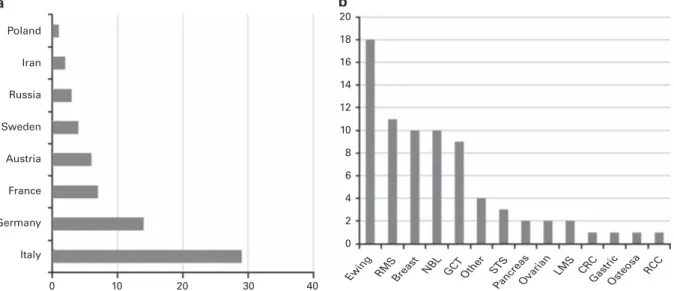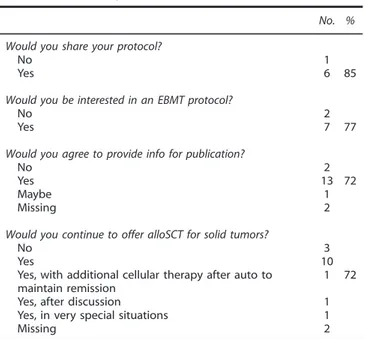LETTER TO THE EDITOR
Is allogeneic transplant for solid tumors still alive?
Bone Marrow Transplantation advance online publication,25 January 2016; doi:10.1038/bmt.2015.345
Immune therapy for cancer is being pursued with extraordinary interest by investigators and pharma industries, given the new scientific acquisitions on immune mechanisms that control cancer and the introduction to clinical use of checkpoint inhibitor molecules, ipilimumab (anti-CTLA4) and nivolumab/pembrolizu-mab (PD-1/PDL-1 inhibitors) among others.1
The paradigm for immune therapy of cancer is allogeneic stem cell transplantation, whose therapeutic effect is carried out by immunocompetent T cells of the donor, an effect known as graft-versus-leukemia or graft-versus-tumor effect (GVT).2 After anec-dotal reports in breast and lung cancer, Childs et al.3reported in 2000 a consistent GVT effect of allogeneic stem cell transplant against renal cell cancer. GVT effect was then investigated in other tumors: As STWP of the EBMT, we completed several studies of allografting in selected solid tumors, namely renal cell cancer,4 ovarian cancer,5breast cancer,6colorectal cancer7and others, with circumstantial evidence of GVT in some tumors and occurrence of transplant-related toxicities, mostly GvHD. In renal cell cancer, we have shown a long-term survival effect in a fraction (20%) of patients.8
Since 2004, when molecularly targeted drugs were introduced into the clinic for renal cell cancer (for example, sorafenib and sunitinib), patient referral for transplant dropped precipitously, and transplant rate evaluation for solid tumors from 2009 was limited to a few patients in Europe (Figure 1).
We were interested to know whether allografting for solid tumors should be considered to be an obsolete procedure, or if it still has a place in the therapeutic armamentarium of transplant clinicians. In February 2015, before the Annual Meeting of the EBMT in Istanbul, we scrutinized the EBMT Registry, and retrieved all cases of allotransplant in solid tumors performed in adult
patients (418-year old) in the years 2009–2014. Six hundred and forty Centers routinely report their transplant activity to the EBMT Registry: overall, 38 centers from 8 countries performed an allogeneic stem cell transplant procedure in 63 patients with solid tumors. The Centers were located in 8 European countries (Table 1). In the 2009–2014 time period, the median number of allogeneic transplant in solid tumors was 1 per Center (range 1–6).
We sent a questionnaire to the EBMT centers that had performed allogeneic transplants in solid tumors in that time period. Questions investigated the interest to pursue allografting in solid tumors in the context of EBMT protocols, in detail: 1. Did you perform transplant on a compassionate basis? 2. Do you have a protocol for such transplants?
J if yes: would you be willing to share your protocol with other interested EBMT centers?
J if not: would you be interested in an EBMT protocol for this disease?
3. Would you be interested to provide information on your transplants for a publication?
4. Based on your previous experience, would you continue to offer patients with solid tumors an allogeneic SCT?
Thirty eight Centers who had transplanted 63 patients were contacted. Eighteen (47%) agreed to contribute data, for a total of 32 patients (51%). The diagnoses of the allografted patients are reported in Table 2. Twelve centers had performed transplants on a compassionate basis (that is, without a clinical protocol; 67%), six had at least one protocol in place for solid tumors (33%). In these Centers, eight protocols are still active and recruiting patients. Six out of seven centers (85%) were willing to share their protocols with other EBMT Centers. Seven of 18 (39% of the Centers who
Poland Iran Russia Sweden Austria France Germany Italy 0 10 20 30 40 20 18 16 14 12 10 8 6 4 2 0
Ewing RMSBreast NBL GCT Other ST S
PancreasOvarian LMS CRC
GastricOsteosa RCC
a b
Figure 1. Number of allogeneic transplants in solid tumors in EBMT Countries in 2009–2014 (a) and number of transplants per disease 2009–2014 (b). CRC: colo-rectal cancer; GCT: germinal cell tumor; OsteoSa: osteosarcoma; LMS: leiomyosarcoma; NBL: neuroblastoma; OsteoSa: osteosarcoma; RCC: renal cell cancer; RMS: rhabdomyosarcoma; STS: soft-tissue sarcoma.
Bone Marrow Transplantation (2016), 1–2
© 2016 Macmillan Publishers Limited All rights reserved 0268-3369/16 www.nature.com/bmt
participated in the survey) would be interested in a common EBMT protocol, and 13 (72%) would agree to provide their data for publication. To the last question (‘Would you continue to offer alloSCT for solid tumors?’), 3 centers answered no, 10 centers answered yes (55%) and 3 additional centers replied yes with
further specifications (yes, with additional cellular therapy; yes after discussion; yes in very special situations; 72%; Table 3).
This survey provided a picture of the status of allogeneic transplantation for solid tumors in EBMT centers. In contrast to our expectations, allogeneic transplant for solid tumors has not been abandoned, even if its use has been markedly reduced. The response rate of the centers to the survey was low (18/38, 47%), as expected since most Centers reported just one transplant. This procedure was mostly used in Italy and Germany, and in a few other centers in France and Austria, mostly for young adults with tumors that are frequent in the pediatric population (rhabdomyo-sarcoma, Ewing’s sarcoma and neuroblastoma), and in a few cases of‘adult-type’ tumors (breast, ovarian and pancreatic cancer). With the exception of HER2-positive breast cancer, these are tumors in which few advances have been made in the last years with targeted therapies. As expected, many transplants have been performed outside a clinical protocol, a behavior that should be avoided in case of experimental procedures.
In conclusion, allograft for solid tumors as adoptive immunotherapy is still being used in EBMT Centers, in a few centers and in a few selected indications. Centers are willing to share data, adopt common protocols and continue to use this strategy in highly selected cases.
CONFLICT OF INTEREST
The authors declare no conflict of interest.
M Bregni1, M Badoglio2, P Pedrazzoli3and F Lanza4on behalf of the STWP of the EBMT 1Medical Oncology Unit, AO Ospedale di Circolo, Department of Oncology, Busto Arsizio, Italy; 2
EBMT Clinical Trial Office, Hôpital Saint Antoine, Paris, France; 3
Medical Oncology Unit, IRCCS Policlinico San Matteo, Department of Oncology, Pavia, Italy and 4
Hematology Unit, Ospedale Cremona, Cremona, Italy E-mail: [email protected]
REFERENCES
1 Ribas A. Releasing the brakes on cancer immunotherapy. N Engl J Med 2015;373: 1490–1492.
2 Weiden PL, Flournoy N, Thomas ED, Prentice R, Fefer A, Buckner CD et al. Antileukemic effect of graft-versus-host disease in human recipients of allogeneic-marrow grafts. N Engl J Med 1979;300: 1068–1073.
3 Childs R, Chernoff A, Contentin N, Bahceci E, Schrump D, Leitman S et al. Regression of metastatic renal-cell carcinoma after nonmyeloablative allogeneic peripheral-blood stem-cell transplantation. N Engl J Med 2000;343: 750–758. 4 Barkholt L, Bregni M, Remberger M, Blaise D, Peccatori J, Massenkeil G et al.
Allogeneic haematopoietic stem cell transplantation for metastatic renal carcinoma in Europe. Ann Oncol 2006;17: 1134–1140.
5 Bay J-O, Cabrespine-Faugeras A, Tabrizi R, Blaise D, Viens P, Ehninger G et al. Allogeneic hematopoietic stem cell transplantation in ovarian cancer-the EBMT experience. Int J Cancer 2010;127: 1446–1452.
6 Ueno NT, Rizzo JD, Demirer T, Cheng YC, Hegenbart U, Zhang M-J et al. Allogeneic hematopoietic cell transplantation for metastatic breast cancer. Bone Marrow Transplant 2008;41: 537–545.
7 Aglietta M, Barkholt L, Schianca FC, Caravelli D, Omazic B, Minotto C et al. Reduced-intensity allogeneic hematopoietic stem cell transplantation in metastatic color-ectal cancer as a novel adoptive cell therapy approach. The European group for blood and marrow transplantation experience. Biol Blood Marrow Transplant 2009; 15: 326–335.
8 Bregni M, Bernardi M, Servida P, Pescarollo A, Crocchiolo R, Treppiedi E et al. Long-term follow-up of metastatic renal cancer patients undergoing reduced-intensity allografting. Bone Marrow Transplant 2009;44: 237–242.
Table 1. Number of centers per country
Country Nr of Centers Italy 6 Germany 6 France 2 Austria 2 Sweden 1 Poland 1 Iran 1 Russia 1
Table 2. Diagnosis of solid tumors
Diagnosis No. of transplants %
Rhabdomyosarcoma 9 28 Ewing sarcoma 7 22 Breast carcinoma 4 12 Neuroblastoma 3 9 Ovarian carcinoma 1 3 Mesenchymoma 1 3 Thymoma 1 3 Colorectal adenocarcinoma 1 3
Soft tissue sarcoma 1 3
Other kidney tumor including renal cell 1 3 Bone sarcoma (excluding Ewing/primary
neuroectodermal tumors)
1 3
Testicular carcinoma 1 3
Pancreatic cancer 1 3
Table 3. Answers to questionnaire
No. % Would you share your protocol?
No 1
Yes 6 85
Would you be interested in an EBMT protocol?
No 2
Yes 7 77
Would you agree to provide info for publication?
No 2
Yes 13 72
Maybe 1
Missing 2
Would you continue to offer alloSCT for solid tumors?
No 3
Yes 10
Yes, with additional cellular therapy after auto to maintain remission
1 72
Yes, after discussion 1
Yes, in very special situations 1
Missing 2
Letter to the Editor
2

